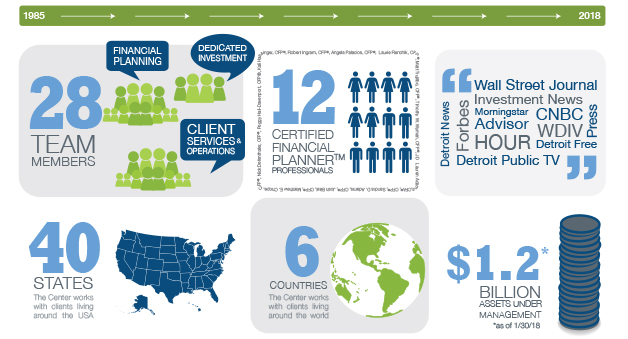 Contributed by: Center for Financial Planning, Inc.®
Contributed by: Center for Financial Planning, Inc.®
Center for Financial Planning, Inc.® is pleased to announce that Timothy Wyman, CFP®, JD has been named to two prominent 2018 financial advisors lists, including Forbes 2018 list of "Best -in-State" Wealth Advisors in Michigan, where he ranked 25th in the state.
Tim was also named to the 2018 edition of the Financial Times 400 Top Financial Advisers. The list recognizes top financial advisers at national, independent, regional and bank broker-dealers from across the U.S.
"Being named to these two 2018 top financial advisor lists is a reflection of Tim's excellence and leadership with clients," said Sandy Adams, Partner and CERTIFIED FINANCIAL PLANNER™. "Tim likes to say, what we do at The Center is to help people with their life's most important financial goals."
In addition to working directly with clients and helping them achieve their financial goals, Tim also acts as Branch Manager, Partner and member of the firm’s Business Operations Committee. Tim is an active member of the Small Giants community whose mission is putting people before profits. Having gone through Leadership Oakland's program, Tim now serves his community as a member of their Board of Directors.
As with any milestone, we are pleased to share with you, especially because Tim is such a driving force and inspiration to the culture you feel when you come into the office. Thank you to you, our clients and friends, for being a part of The Center team.
The Forbes ranking of Best-In-State Wealth Advisors, developed by SHOOK Research is based on an algorithm of qualitative criteria and quantitative data. Those advisors that are considered have a minimum of 7 years of experience, and the algorithm weighs factors like revenue trends, AUM, compliance records, industry experience and those that encompass best practices in their practices and approach to working with clients. Portfolio performance is not a criteria due to varying client objectives and lack of audited data. Out of 21,138 advisors nominated by their firms, 2,213 received the award. This ranking is not indicative of advisor's future performance, is not an endorsement, and may not be representative of individual clients' experience. Neither Raymond James nor any of its Financial Advisors or RIA firms pay a fee in exchange for this award/rating. Raymond James is not affiliated with Forbes or Shook Research, LLC.
The FT 400 was developed in collaboration with Ignites Research, a subsidiary of the FT that provides specialized content on asset management. To qualify for the list, advisers had to have 10 years of experience and at least $300 million in assets under management (AUM) and no more than 60% of the AUM with institutional clients. The FT reaches out to some of the largest brokerages in the U.S. and asks them to provide a list of advisors who meet the minimum criteria outlined above. These advisors are then invited to apply for the ranking. Only advisors who submit an online application can be considered for the ranking. In 2018, roughly 880 applications were received and 400 were selected to the final list (45.5). The 400 qualified advisers were then scored on six attributes: AUM, AUM growth rate, compliance record, years of experience, industry certifications, and online accessibility. AUM is the top factor, accounting for roughly 60-70 percent of the applicant's score. Additionally, to provide a diversity of advisors, the FT placed a cap on the number of advisors from any one state that's roughly correlated to the distribution of millionaires across the U.S. The ranking may not be representative of any one client's experience, is not an endorsement, and is not indicative of advisor's future performance. Neither Raymond James nor any of its Financial Advisors pay a fee in exchange for this award/rating. The FT is not affiliated with Raymond James. For more information see www.SHOOKresearch.com.
Links are being provided for information purposes only. Raymond James is not affiliated with and does not endorse, authorize or sponsor any of the listed websites or their respective sponsors. Raymond James is not responsible for the content of any website or the collection or use of information regarding any website's users and/or members.

















